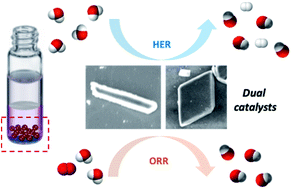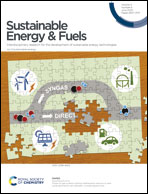Facile synthesis of C60-nano materials and their application in high-performance water splitting electrocatalysis†
Abstract
Here, we report the synthesis and characterization of crystalline C60 nanomaterials and their applications as bifunctional water splitting catalysts. The shapes of the resulting materials were tuned via a solvent engineering approach to form rhombic-shaped nanosheets and nanotubes with hexagonal close packed-crystal structures. The as-synthesized materials exhibited suitable properties as bifunctional catalysts for HER and ORR reactions surpassing by far the electrocatalytic activity of commercially available amorphous C60. The C60 nanotubes displayed the most efficient catalytic performance with a small onset potential of −0.13 V vs. RHE and ultrahigh electrochemical stability properties towards the generation of molecular hydrogen. Additionally, the rotating-disk electrode measurements revealed that the oxygen reduction mechanism at the nanotube electrochemical surfaces followed an effective four-electron pathway. The improved catalytic activity was attributed to the enhanced local electric fields at the high curvature surfaces.



 Please wait while we load your content...
Please wait while we load your content...